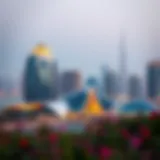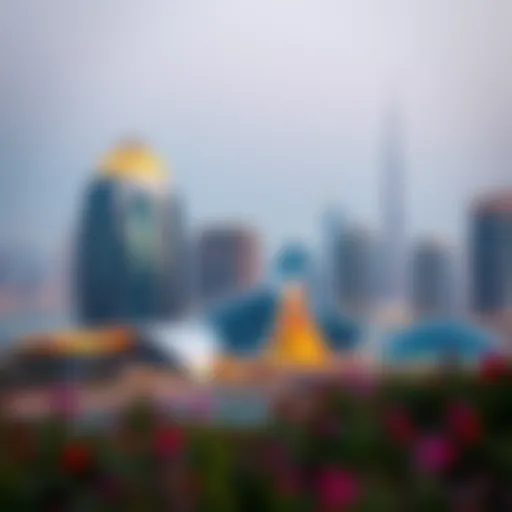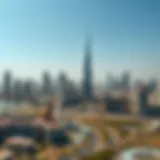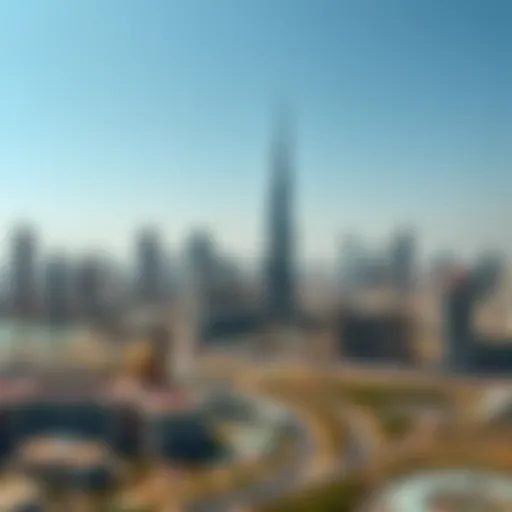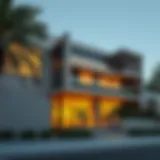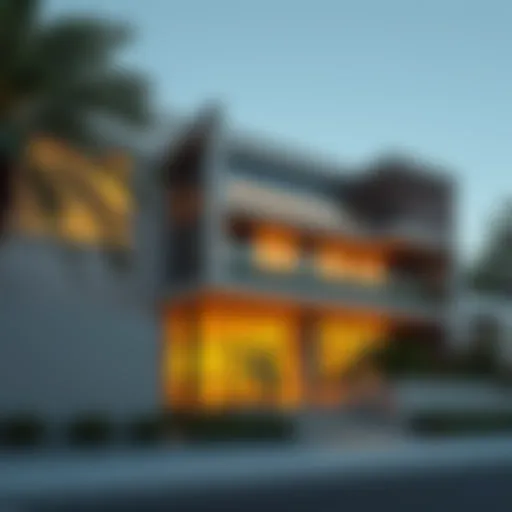International City Phase 1: Insights and Opportunities
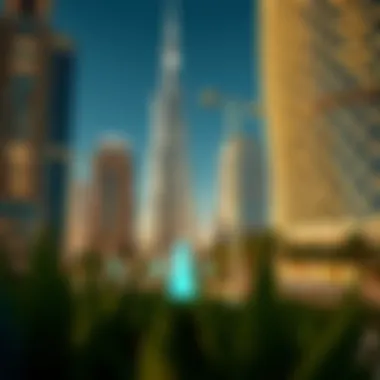

Intro
International City Phase 1 stands as a testament to Dubai’s rapid urbanization and evolving real estate landscape. Positioned as a global city with lofty ambitions, Dubai has crafted International City Phase 1 with a vision that transcends mere living spaces. This burgeoning hub is not just about brick and mortar; it embodies a lifestyle, an investment opportunity, and a community pulsating with cultural diversity. Understanding the complexities of this urban development is paramount for potential investors, homebuyers, and property managers keen on tapping into one of the most vibrant markets in the Middle East.
As we venture deeper into this exploration, we will unfold the key trends shaping the real estate market in International City Phase 1, insights that can guide both seasoned investors and novices alike. We’ll sift through the architectural innovations that pepper the skyline, examine market conditions, and identify promising growth areas. This analysis also aspires to shine a light on the unique lifestyle offerings that make this locale particularly attractive. In essence, what lies ahead is a comprehensive guide that seeks to equip you with the knowledge to navigate the opportunities within International City Phase 1.
Market Trends
Current Real Estate Market Conditions
The real estate sector in International City Phase 1 is currently characterized by a harmonious blend of affordability and quality. With a property price point that resonates well with middle-income families and first-time buyers, it has emerged as a beacon of opportunity amidst Dubai's high-end competition. The market is currently witnessing a steady demand for both rental and purchase properties, attributable to its strategic location and vibrant community dynamics.
"As more expatriates flock to Dubai, International City is seeing an influx of buyers looking for affordable yet appealing options in a rapidly appreciating market."
Each sector of International City showcases its own unique attributes. From thematic neighborhoods, like the Chinese and Moroccan clusters, to ample green spaces adorned with walking paths, residents often find their preferences catered to. This livability factor enhances demand, pushing prices upward, albeit gradually—a stark contrast to more inflated areas across the city.
Future Projections and Growth Areas
Diving into the projections, the future of International City Phase 1 appears promising. Industry analysts are noting that as Dubai continues to expand its infrastructure, key growth areas are on the horizon.
- Integration with New Metro Lines: Upcoming metro projects are expected to significantly enhance accessibility, boosting property values. Areas close to potential stations are particularly poised for appreciation.
- Commercial Development: New commercial hubs are in the pipeline, likely to draw businesses and job seekers, creating a ripple effect on housing demand.
- Tourism Growth: With Dubai's tourism sector recovering, International City’s unique cultural offerings may draw more visitors, further stoking demand for residential properties.
It becomes clear that while current conditions are favorable, the underlying factors driving growth bode well for sustained demand and potential upsurges in property values—offering fertile ground for investors to plant their seeds.
Investment Insights
Best Areas for Real Estate Investment
Investors often wonder where to place their bets in a robust market like International City Phase 1. Here are some standout areas:
- Themed Clusters: Areas like the Moroccan and Chinese clusters are not only rich in culture but also attract diverse demographics, ensuring a steady demand for both rental and purchase.
- Proximity to Amenities: Locations near essential services like schools, healthcare facilities, and shopping areas fetch higher value due to their enhanced livability.
- Green Spaces: Properties with access to parks or communal areas often have a higher attraction quotient, especially among families.
Identifying properties in these key areas can pay dividends down the line, especially as the urban fabric continues to evolve.
Tips for First-Time Investors
For those new to the real estate game, International City Phase 1 presents a myriad of opportunities. To navigate this market effectively, consider the following tips:
- Do Your Research: Familiarize yourself with local regulations, market trends, and the historical performance of properties.
- Engage Local Experts: Utilize the knowledge of real estate agents familiar with the area to guide your investment.
- Be Clear on Your Goals: Define whether you plan to rent out your property or occupy it. This clarity helps in making informed decisions.
- Assess Financing Options: Explore different financing methods; some banks offer favorable loan terms for first-time buyers.
By weaving together insights on the market trends, growth areas, and strategic investment tips, prospective buyers and investors can arm themselves with the knowledge needed to thrive in the bustling realm of International City Phase 1. As this area continues to burgeon, the time to act may very well be now.
Understanding International City
Understanding International City is pivotal for grasping its significance within Dubai’s urban landscape. This section unpacks the layers that make the International City project not just a geographical area but a melting pot of cultures, lifestyles, and investment opportunities. The importance of this topic lies in its capacity to inform potential investors, home buyers, and property managers about the dynamics that drive the value of properties in the area.
International City is more than just a collection of buildings; it is a thoughtfully designed urban space crafted to promote community living. By dissecting its features and historical context, an investor can better understand their potential for returns and the lifestyle benefits on offer.
The advantages of familiarizing oneself with International City include:
- Cultural Diversity: The development celebrates a variety of lifestyles—everything from European districts to Asian marketplaces, appealing to people from all walks of life.
- Affordability: Offering competitive property prices compared to other Dubai developments, it attracts a wide range of buyers, thereby ensuring liquidity in the market.
- Sustainable Growth: The targeted infrastructure development and long-term planning signal a strategic growth trajectory that appeals to long-term investments.
By dissecting these elements, stakeholders can better assess opportunities and challenges that lie ahead.
Overview of International City
International City emerges as a prominent urban layout within Dubai's real estate sector. Spread over 800 hectares, this planned community was envisaged to embody a cosmopolitan lifestyle, blending residential, commercial, and recreational spaces. Originally launched in the early 2000s, it has established itself as a cost-effective living solution amidst the opulent backdrop of Dubai.
One of the standout features of International City is its thoughtfully partitioned zones that represent various countries and cultures. Each district, from the China Cluster to the France Cluster, offers unique architectural styles and community vibes. This diversity not only enriches the living experience but also fosters a sense of belonging for expatriates from different corners of the world.
Additionally, the strategic location of International City enhances its appeal. Situated just minutes away from Dubai's key highways, like the Sheikh Mohammed Bin Zayed Road, it offers easy access to the rest of the city, making commuting a breeze for residents.
"International City symbolizes the nexus where affordability meets cultural richness, creating a unique opportunity in Dubai’s booming property market."
Historical Context
A glance into the historical development of International City reflects its evolution from a mere concept into a bustling urban landscape. Launched in the early 2000s, it was part of Dubai’s broader strategy to accommodate the growing expatriate population and diversify its real estate offerings beyond luxury developments.
Initially, the project faced its share of challenges, including fluctuating market conditions and global economic crises. During the late 2000s, the property market suffered a downturn, pushing the project into a slower phase of development. However, once the dust settled, International City regained traction, aided by the UAE's recovery and positive economic indicators.
Understanding this historical context not only lends insight into the agility and resilience of the Dubai real estate market but also serves to demystify the potential future trajectory for new investors. It provides critical insight into how urban developments can adapt and thrive even amidst broader economic uncertainties.
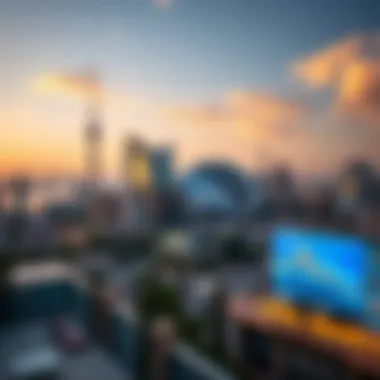

Phase Development
The development of Phase 1 is integral to understanding the broader context of International City. This segment is not just about building physical structures; it’s about creating a self-sufficient urban environment that appeals to both residents and investors alike. The planning and execution of Phase 1 have laid down a solid foundation for future growth, blending infrastructural advancements with community-focused design principles. It is essential for potential stakeholders to grasp the significance of this venture, especially as it sets the tone for subsequent phases of development.
Construction Timelines
Delving into the construction timelines for Phase 1 provides clarity on the project’s momentum and commitment. Groundbreaking started back in 2002, aiming to establish International City as a hub for expatriates and families. The journey was shaped by
- early planning approvals,
- challenges during the construction phase, and
- the slow but steady rollout of essential infrastructure.
Various contractors took the reins, emphasizing quality and durability. By 2005, the first residential blocks were unveiled, signaling that the project was more than just concrete and steel; it was about forging a vibrant community. This timeline is crucial not only for historical context but also for predicting future investments in the real estate market here.
Architectural Features
The architectural features of Phase 1 are a testament to careful planning and innovative designs. From a mix of residential and commercial structures, the aesthetic choices reflect a diverse cultural influence that aims to appeal to a broad demographic. The layout incorporates:
- multi-storey buildings with varying heights for visual interest,
- open courtyards and green spaces fostering a sense of community,
- convenient access points for pedestrians and vehicles, ensuring ease of movement.
In essence, the buildings are designed to maximize natural light and ventilation, promoting sustainability. Materials selected focus on durability and aesthetics, aligning with Dubai’s increasing commitment to high standards in urban development.
Design Philosophy
The design philosophy behind Phase 1 emphasizes creating a cohesive urban identity that embodies cultural diversity while providing comfort and accessibility. The concept revolves around:
- Community integration, ensuring that amenities and services are within walking distance,
- Sustainability, introduced through eco-conscious building practices that cater to the future,
- Aesthetic beauty, where architecture is not merely functional but embodies artistic expression.
This approach aims to foster a sense of belonging among residents, transforming International City into a vibrant urban oasis. The focus on livability is critical, given the ever-evolving needs of modern societies.
The architectural narrative in Phase 1 not only defines the physical boundaries but also cultivates a social fabric that enriches the lifestyles of those who call this place home.
Investment Opportunities
Investment opportunities in International City are as vast as the desert surrounding it. This article seeks to uncover not just the available options, but also the long-term benefits and considerations for investors looking at this unique urban development in Dubai.
Market Potential
The market potential of International City is quite compelling. Located strategically, the area is poised for growth due to ongoing infrastructure developments and an increasing population. According to various reports, Dubai's real estate market is showing signs of revival and stability. In 2022, property prices saw a moderate increase, drawing the attention of both local and international investors. Its diverse demographic also helps maintain a steady demand for properties.
The locality’s offerings range from residential apartments to commercial spaces. Potential buyers are particularly interested in how developments cater to different income brackets. There’s something for everyone here. As demand increases, so do opportunities for higher returns on investments, making the market ripe for those willing to take the plunge.
Comparative Analysis
When we compare International City with other well-established areas like Downtown Dubai and Dubai Marina, the pricing difference is notable. While Prime locations may command higher prices per square meter, International City provides a more cost-effective alternative without sacrificing lifestyle quality.
Moreover, areas such as Jumeirah Village Circle and Dubai Sports City face stiff competition with higher living costs, offering less bang for the buck. Investors who think outside the box may find International City a goldmine for setting up rental properties or commercial ventures that are attractive to both expats and Emiratis alike.
- Pros of Investing in International City:
- Cons of Investing in International City:
- Lower entry costs compared to premium zones
- High demand for rentals due to diverse population
- Ongoing infrastructure development enhancing connectivity
- Risk of oversupply if too many units get built
- Possibly less prestige than more developed areas
Rental Yields
Rental yields in International City linger around a healthy figure of 5% to 7%, depending on the property type and location within the development. This far surpasses many areas in Dubai, creating a lucrative environment for property owners. As an investor, this is an enticing figure, especially when compared to less favorable yields elsewhere in the city.
Data suggests that everyday necessities, entertainment options, and proximity to work are significant factors in attracting tenants.
The wide range of amenities such as supermarkets, schools, parks, and restaurants makes it appealing for both families and single professionals. With the continuous influx of expatriates, the demand for rental units will likely keep climbing.
"Investors can find a sweet spot in International City, balancing yield and affordability in a cosmopolitan setting."
Lifestyle in International City
Examining lifestyle options in International City is crucial for understanding its appeal to different demographics. This area has been developed to provide a blend of comfort and convenience, drawing both residents and investors alike. Lifestyle offerings play a vital role in fostering a sense of community, making this locale an attractive choice for those looking to establish roots or invest in a promising market.
Residential Options
International City boasts a variety of residential options that cater to diverse tastes and budgets. From stylish apartments to spacious villas, each housing unit is designed with modern living in mind. Particularly, the Dragon Mart area has gained popularity for those seeking affordable yet appealing accommodation.
- Here are some options:
- Studio apartments: Perfect for singles or young couples, these units offer a cozy living space without breaking the bank.
- One- and two-bedroom apartments: These are favored by small families looking for a balance of space and affordability.
- Villas: For those seeking more room, the villas provide a private backyard, ideal for families who enjoy outdoor activities.
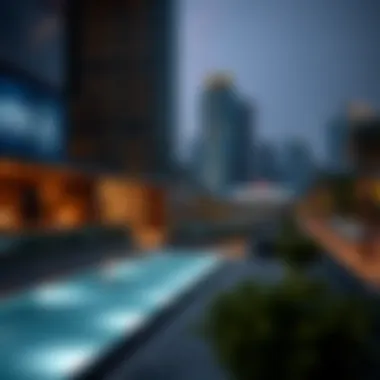

Providing options to suit various lifestyles ensures that residents feel at home, which in turn maintains high demand in the housing market.
Community Amenities
The community amenities in International City significantly contribute to its livability. Access to essential services and leisure facilities enhances the everyday lives of residents.
Residents can enjoy:
- Swimming pools: These provide a refreshing escape from the heat.
- Gym facilities: A vital area for health enthusiasts, ensuring residents have access to fitness resources.
- Parks and green spaces: These allow families to enjoy outdoor activities, fostering community engagement.
Convenience stores, pharmacies, and cafes can be found within reach, making daily errands easy and efficient. The integration of amenities creates a cohesive living experience that attracts both residents and tourists.
Cultural Aspects
The cultural aspects of International City are rich and diverse, reflecting the multicultural fabric of Dubai itself. Residing here means experiencing influences from various global cultures.
Several cultural elements include:
- Restaurants: A wide range from Middle Eastern to Asian and European cuisines, showcasing the culinary diversity.
- Cultural events: Occasional festivals and exhibitions that celebrate various heritages, offering a sense of belonging for expatriates.
- Art installations: Public art pieces scattered throughout the community that add character and encourage exploration.
The blend of cultural experiences here enhances the social fabric, making it a fascinating place to live.
Overall, the lifestyle offered in International City is multi-faceted, catering to a wide range of preferences and needs, while establishing a distinct identity within the larger context of Dubai's urban development. Investors and home buyers alike should take into account how these lifestyle elements can influence property value and demand in the foreseeable future.
Regulatory Environment
The regulatory environment surrounding International City Phase 1 in Dubai plays a pivotal role for everyone involved, be it investors or potential homebuyers. Understanding this landscape is crucial for navigating the complexities of property acquisition and investment in the region. Regulatory frameworks not only safeguard the interests of owners but also ensure that the urban development aligns with the broader goals of sustainability and growth.
Key Considerations:
- Regulations provide a foundation for fair dealing in real estate transactions.
- They protect property rights and investments, fostering confidence among investors.
- A clear regulatory framework enhances the attractiveness of the location for foreign buyers, contributing to economic growth.
Benefits of a Structured Regulatory Environment:
- Transparency: Established guidelines enhance transparency, allowing all stakeholders to understand their rights and obligations.
- Security: Clear regulations create a sense of security for property owners, minimizing the risks associated with ownership and investments.
- Framework for Growth: Regulations often set the stage for urban planning and development, ensuring that cities grow in a way that meets community needs and expectations.
- Investor Confidence: A robust regulatory framework enhances investor confidence, attracting capital inflow into the property market.
“Regulations are not just a hurdle; they are the rail on which the train of property development runs.”
Real Estate Regulations
Real estate regulations in International City provide a clear framework within which properties are bought, sold, and managed. They address various elements such as zoning laws, building codes, and property taxation, all aimed at maintaining an organized and aesthetically pleasing urban space.
Important Aspects of Real Estate Regulations:
- Zoning Laws: These laws dictate how land in certain areas can be used, which affects the type of properties that can be developed. For instance, residential areas are typically separated from industrial zones to preserve community lifestyles.
- Building Codes: Ensuring that construction meets safety and architectural standards is vital. These codes cover everything from structural integrity to energy efficiency.
- Taxation Policies: Understanding property taxes and other financial obligations is essential for both investors and potential homeowners. These taxes can significantly impact the overall investment yield.
For investors, keeping abreast of changes in real estate regulations can provide a competitive edge. Knowing when to invest or where to focus can be influenced by shifts in the regulatory landscape.
Foreign Ownership Policies
The foreign ownership policies in Dubai are particularly inviting, striking a balance between state interests and the need for external investment. These policies define the extent to which non-residents can acquire property, which is crucial for understanding the landscape of International City Phase 1.
Key Points about Foreign Ownership Policies:
- Ownership Limits: In many areas of Dubai, foreigners can own up to 100% of properties. However, understanding the specific areas designated for such ownership is critical. International City specifically allows for full foreign ownership.
- Regulatory Compliance: Foreign investors must comply with local laws, which may include registration with various government bodies. Familiarity with these requirements can streamline the purchasing process, helping avoid unnecessary delays.
- Investment Incentives: The policies often include incentives, such as residency permits in exchange for property investment, encouraging foreign investments.
Benefits for Foreign Investors:
- Access to a thriving market without local partnerships.
- Participation in a growing economy with a favorable investment climate.
In summary, grasping the regulatory environment, real estate regulations, and foreign ownership policies is not merely advised—it is necessary for successful navigation of the International City Phase 1 market. Armed with this knowledge, investors, homebuyers, and property managers can make informed and strategic decisions.
Transport and Accessibility
Transport and accessibility play a crucial role in determining the livability of any urban development. When considering International City Phase 1 in Dubai, the efficiency of transportation systems significantly enhances the attractiveness of this locale for investors, home buyers, and property managers. A well-connected area not only boosts property values but also enriches the lifestyle experience for residents. It's about ensuring that people can easily move about, whether they're commuting for work, heading to leisure activities, or conducting daily errands.
Public Transport Options
Public transportation is the lifeblood of urban environments, particularly in a bustling metropolis like Dubai. International City Phase 1 benefits from a variety of public transport options, which make accessing the wider city a breeze:
- Bus Services: A network of bus routes connects International City to key areas of Dubai, including commercial hubs and cultural centers. These buses are reliable and frequent, which is a boon for daily commuters.
- Metro Accessibility: While the nearest metro stations may require a short drive or bus ride, the extension of the Dubai Metro services is ongoing, aiming to bring more proximity to this area. Once in place, this will substantially improve travel convenience.
- Taxi Services: Taxis are easily available, providing another dimension of accessibility. Ride-hailing services like Uber and Careem offer residents swift and direct transport solutions, making distance feel negligible.
The integration of these systems facilitates not just daily routines but also contributes to a reduced carbon footprint, aligning with sustainability goals.


Proximity to Major Routes
In addition to its internal transport options, the location of International City Phase 1 is advantageous due to its strategic proximity to major roadways. This aspect is vital for both residents and businesses:
- Access to Emirates Road: Being near the Emirates Road grants residents seamless connectivity across the emirates. This route is a major artery, linking Dubai to neighboring emirates, making travel between cities hassle-free.
- Sheikh Mohammed Bin Zayed Road: This highway is another critical route, providing quick access to commercial areas, Dubai International Airport, and other vital amenities. It's a go-to for anyone residing in International City who needs to travel for work or leisure.
- Commuter Convenience: The close-knit access to these routes means that traffic congestion is minimized, allowing for quicker commutes. This not only enhances the quality of life for residents but also appeals to potential investors who appreciate the importance of reduced travel times.
In short, the transport infrastructure of International City Phase 1 significantly contributes to its overall appeal. Investing in a property here means having the comfort of knowing that both personal and public transport is within arm's reach. Whether it’s a leisurely weekend trip or the daily grind, accessibility is paramount.
The combination of available public transport options and the strategic location near major routes makes International City Phase 1 an attractive choice in the ever-evolving landscape of Dubai real estate. This is essential information for those looking to invest or find a home in a community that prides itself on connectivity.
Environmental Considerations
Understanding the environmental considerations surrounding International City Phase 1 is crucial. This phase does not merely focus on urban development; it also strives to harmonize the growth with ecological sustainability. In an age where climate change and environmental degradation are at the forefront of global conversations, the need for better planning has never been greater. It’s not just about bricks and mortar but about creating a livable space that respects and nurtures the environment.
The key benefits of integrating environmental considerations into the development include:
- Enhanced Quality of Life: Residents can enjoy a cleaner, healthier environment.
- Long-term Cost Savings: Sustainable practices often lead to decreased utility and maintenance costs.
- Increase in Property Value: Properties backed by green initiatives tend to attract buyers and renters, offering better returns on investment.
This endeavor influences various aspects, including land use, energy consumption, and even waste management.
Sustainability Initiatives
International City Phase 1 is aligned with several sustainability initiatives aimed at reducing the ecological footprint. Among these are strategies to minimize resource waste, integrate renewable energy sources, and promote eco-friendly transportation. The developers are not turning a blind eye to energy-efficiency; they are integrating practices that promise to maximize the use of natural light and enhance ventilation. Two prominent initiatives are:
- Solar Energy Utilization: Installation of solar panels on select buildings is part of this initiative, harnessing sunlight for electricity.
- Water Conservation Practices: Smart irrigation systems and water recycling systems are vital. They not only bolster sustainability but also contribute to the attractiveness of the community.
These initiatives are essential not just for the present but also for future generations. It is crucial to adopt a lifestyle that supports sustainable development, aligning the desires of today with the needs of tomorrow.
Green Spaces and Nature
Green spaces are an integral aspect of urban planning in International City Phase 1. They provide a necessary respite from the urban jungle, contributing to the psychological and physical well-being of the community. Here, parks, gardens, and quiet nature spots are thoughtfully scattered throughout the development.
The benefits of incorporating green spaces include:
- Improved Mental Health: Access to natural surroundings can alleviate stress and enhance the quality of life.
- Biodiversity: Well-planned green areas support local wildlife, enhancing ecological diversity.
- Community Engagement: Parks and recreational areas can serve as hubs for social interaction, fostering a sense of community.
"Green spaces not only beautify urban environments but are essential for the ecological and social health of a city."
In the Society of International City, areas like public gardens and walking trails are well-planned, emphasizing the importance of nature in everyday life. Add to that the potential for community gardening, and this phase showcases how urbanity need not come at the expense of nature.
Future Prospects
The future prospects of International City Phase 1 are not merely an abstract consideration but a tangible reflection of the strategic vision that underlies urban development in Dubai. As the city pushes onward in its ambitions to assemble a global hub for businesses, tourism, and trade, International City stands as a vital component of this evolving narrative. The importance of understanding these prospects goes beyond the immediate investment allure; it speaks to the potential shifting landscape and how it aligns with the socio-economic threads of the region.
Upcoming Developments
The trajectory of new developments in International City Phase 1 reveals much about the aspirations held for this district. Several projects are on the horizon, each designed to complement the existing infrastructure while enhancing community cohesion and commercial viability. For instance, new retail spaces are slated to open, aimed at boosting local commerce and providing residents with much-needed conveniences. Moreover, the improvement of residential facilities is also a focal point, aiming to attract a diverse demographic, from young professionals to families looking to settle down. The forthcoming developments should reinforce the area's status as a vibrant enclave within the expansive urban framework of Dubai.
Key Focus Areas
- Enhancing Commercial Offerings: Efforts are underway to introduce more retail and office spaces to facilitate business operations and foster entrepreneurship.
- Infrastructure Upgrades: Roads and public transport systems are being evaluated for enhancements, potentially including new bus routes or bicycle lanes, offering better connectivity across the region.
- Community Spaces: Upcoming parks and recreational areas are expected to enhance the quality of life for residents, promoting social interaction and outdoor activities.
Long-term Vision for International City
The long-term vision for International City extends beyond mere square footage or population growth. It encapsulates a sustainable and integrated approach to urban living that balances economic growth with quality of life. Decision-makers are not just focused on the next few years but are looking towards a sustainable future. The idea is to develop a comprehensive urban ecosystem that allows for seamless interaction between living, working, and leisure activities. The vision incorporates smart city initiatives that utilize technology to enhance everything from energy efficiency to public safety, positioning International City as a model for future developments.
"The success of International City is rooted not just in its initial design but in the sustainable growth it fosters for future generations."
Aspects to Consider
- Sustainability Goals: The development is aimed at incorporating eco-friendly practices, such as energy-efficient buildings, to meet the rising demand for sustainable living solutions.
- Technological Integration: Smart technologies are to play a vital role in shaping the infrastructure, providing insights into public utilities and traffic management.
- Community Engagement: As the vision unfolds, community input will be vital in shaping amenities and facilities that meet the evolving needs of residents.
In sum, the future prospects for International City Phase 1 are not just about construction but rather about crafting a holistic environment that fosters thriving communities and solid economic growth. Investors and prospective buyers should pay close attention to how these developments unfold, as they signal the direction in which this urban landscape will evolve.
Finale
The conclusion serves as a critical touchstone in comprehending the complex narrative surrounding International City Phase 1. Drawing insights from the previous sections not only encapsulates the vital elements discussed throughout the article but also reinforces the significance of these aspects for various stakeholders. Investors, home buyers, and property managers can greatly benefit from a concise synthesis as they navigate an evolving market landscape.
Summary of Insights
In reviewing the previous discussions, here are the key insights drawn from International City Phase 1:
- Strategic Urban Development: The area stands as a beacon of modern urban planning, designed to provide living and working spaces that reflect both functionality and aesthetics.
- Investment Viability: Its market potential, coupled with favorable rental yields, presents a lucrative opportunity for investors looking to capitalize on emerging real estate trends.
- Lifestyle Enhancements: The community boasts a range of amenities and cultural aspects that enrich the quality of life for residents, setting a foundation for a vibrant living environment.
- Regulatory Landscape: An understanding of the local real estate regulations and foreign ownership policies helps prospective buyers tread carefully in this promising investment terrain.
- Future Developments: Insights into upcoming projects highlight the ongoing transformations, hinting at the promising long-term prospects of the area.
This amalgamation of information transforms abstract concepts into actionable insights, enabling potential stakeholders to make informed decisions driven by data and trends.
Final Thoughts
Reflecting on the journey through International City Phase 1 invokes a sense of anticipation for the future while grounded in current realities. The area exemplifies a blend of modernity, thoughtful planning, and community-centric living, appealing to both investors and residents alike. As Dubai continues to evolve into a major global hub, International City holds a unique position in this narrative. The myriad of opportunities it presents, whether it be through investment or lifestyle enhancement, invites stakeholders to engage with it holistically.
